Ready to learn how to grow corn in your backyard garden? Sweet corn on the cob fresh from the garden is guaranteed to make any meal even better!
Contributed by Jodi Torpey.
Introduction to Sweet Corn (Zea mays var. saccharata)
Sweet corn is one of the joys of summer gardening! What started out as colorful Indian corn developed into a delicious and versatile vegetable for home gardeners.
Fresh, home-grown corn can be eaten fresh on or off the cob, cooked into many dishes, and frozen to save for winter. The husks can be used to make tamales.
How to Grow Corn in Your Backyard
Corn is a warm-season crop that needs heat to grow well. If you wait for the soil to warm to at least 70 degrees before planting, corn seeds will germinate quickly.
There are many varieties of sweet corn to choose from, with maturity dates that range from 65 to 100 days. For a steady supply, plant early, mid-season, and late varieties. An alternate method is to plant one variety, in succession about 7-10 days apart.
Grow Some Greens!
Ready to grow fresh greens, no matter WHERE you live? Sign up for my
FREE quick-start guide and start growing some of your own food!
A Variety of Sweet Corn for Every Gardener
Of the many varieties of sweet corn to plant in your garden, here are a few of the most popular among home gardeners:
White corn has small, sweet kernels
- Silver King has very white sweet kernels that hold their flavor longer than other white corn varieties; about 82 days to maturity.
- Silver Queen is a white corn with large kernels that are especially sweet; about 88 days.
Yellow corn has large, full-flavor kernels
- Golden Bantam is a favorite heirloom corn variety for its old-fashioned corn flavor. This variety can sprout in cooler soil and matures in about 85 days.
- Golden Jubilee is a hybrid sweet corn that’s a late season variety that gardeners like for canning and freezing; matures between 90 and 100 days.
Bicolor corn has both yellow and white kernels for an extra-sweet taste
- Peaches & Cream is a bicolor hybrid that combines sweet white kernels with juicy yellow ones; 70 days to maturity means it’s a good short-season choice.
- Big N’ Tender is a bicolor corn that is known for its uniform ears of juicy kernels; 79 days.
How to Grow Corn from Seed
If you want to grow sweet corn in your vegetable garden, set aside the space you need to grow enough ears to enjoy. Keep in mind that you’ll get about 1-3 ears of corn from each corn stalk. As a rough estimate, a 10-foot row may yield about 24 ears of corn (depending on the variety), so plan accordingly.
Corn is a delicate plant for transplanting, so it’s best to plant seeds directly in garden beds. You can start planting corn about the time of the last average spring frost for your region.
A good approach is to plant seeds several weeks apart to prolong the corn harvest. In warm climates, you may need to stop planting when the temperatures heat up.
In warm climates, you can sow again in mid-summer for a fall harvest. Cooler climates can plant into late June (depending on the days to maturity).
The best planting method is to plant in short blocks of rows, which helps improve pollination. The rows should be placed about three feet apart. Plant seeds about 1½ to 2 inches deep and about 4-5 inches apart in the row.
Once plants germinate and start to grow (about 5-6 inches tall), thin to about 10 inches apart. If you neglect this step, the plants will become overcrowded, resulting in small, partially filled ears of corn.
Corn Tassels and Silk
As corn plants mature, they will develop corn tassels. These are the male part of the stalk and produce pollen. As the pollen drops and is scattered in the wind, it lands on the corn silk emerging from each cob.
Each thread of silk leads to a single kernel of corn on the cob. If a silk is pollinated, a kernel forms. If you’ve ever eaten an ear of corn with sparse kernels, you’ve seen the result of poor pollination. This is why corn should be planted in blocks rather than long rows.
Requirements for Growing Corn
Light Requirements
Corn is one of those plants that needs full sun. Plan for between 6-8 hours of sun each day during the prime growing season for your region.
Soil and Fertilizer Needs
Sweet corn plants need rich, well-amended soil that’s also well-draining soil. Before planting, broadcast a good-quality, pre-plant fertilizer over the planting area and dig in plenty of organic matter, such as compost or well-aged manure. Check with your area’s Cooperative Extension office to see about specific recommendations for your garden’s soil.
While plants are growing, you may need to fertilize periodically. Start feeding about one month after planting and when you see tassels start to form.
Side dress with a fertilizer that’s high in nitrogen to keep plants growing. Side dress by sprinkling the dry fertilizer on the surface of the soil, about 6 inches to the side of each row and then water it in.
Water Requirements
To grow the best ears of sweet corn, keep soil moist, but not soggy. Make sure your watering method, such as a soaker hose, gives plants a consistent supply of moisture, especially once tassels start to appear until it’s time to harvest.
A layer of straw mulch placed between the rows will help maintain soil moisture and keep down the weeds.
Common Pests and Other Corn Growing Problems
Here are some common corn-growing problems and how to handle them:
Birds—Protect seedlings with row cover cloth until they are several inches tall; then remove cover.
Caterpillars—Handpick caterpillars when you see them and drop them in a bucket of soapy water.
Earworms—When silks start to turn brown, apply several drops of vegetable oil to the silks of each ear to prevent earworm damage.
Ears missing kernels—Check for Japanese beetles, earwigs or cucumber beetles; handpick beetles and set out earwig traps (loosely roll up sections of damp newspaper or set out pieces of cardboard where they’ll hide during the day; dispose of the paper rolls each morning.)
Yellowing lower leaves—Signals a nitrogen deficiency; side dress with a nitrogen-rich fertilizer.
How to Grow Corn in Containers
Can you really plant corn in a container? The answer is yes, if you plant the right kind of corn in the right size container.
Burpee Seed Company has a container corn variety called On Deck. This sweet corn variety has bicolor kernels with ears that grow on stalks about 4-feet tall.
Plant seeds in as large a container as you can; the company recommends 24-inch pots. Be sure to start with good-quality potting soil and a slow-release fertilizer. Keep soil moist and fertilize at least once a month.
When to Harvest Corn
Corn will be ready to harvest about three weeks after you see the first silks appear. Keep checking stalks and look for dry and brown silks with ears that fill out the husks.
If you’re still unsure, do a fingernail test: select one stalk, peel back the husk of one ear and use your fingernail to pierce a kernel. If you see a milky juice, the ear is ripe. If not, replace the husk and secure with a rubber band to let plant keep growing.
Using Homegrown Corn in the Kitchen
Use fresh corn as quickly as possible after harvesting it, while the sugar is still high. Keep husks on ears until you’re ready to use them.
Besides eating fresh corn right off the cob, remove kernels to add to salads, cornmeal muffins and other recipes. You can also freeze or can kernels to save and enjoy later.
Saving Corn Seeds
If you want to save your sweet corn seeds to plant next season, be sure to follow these seed-saving practices:
- Save only open pollinated or heirloom corn varieties, not hybrids. Hybrid seeds will revert back to one of the two parent plants.
- Save sweet corn seeds as long as plants haven’t been grown near popcorn, Indian corn or field corn where they could have been cross-pollinated.
- Leave ears to dry on the stalks for several weeks after the harvest; remove ears in their husks before a heavy frost and let them dry thoroughly. Remove seeds and store them in a paper bag; label for next season.
Corn Growing FAQs
How long does it take to grow corn?
60-100 days, depending upon the sweet corn variety, as mentioned above.
Be sure to read about other staple crops you can add to your garden plan this year!

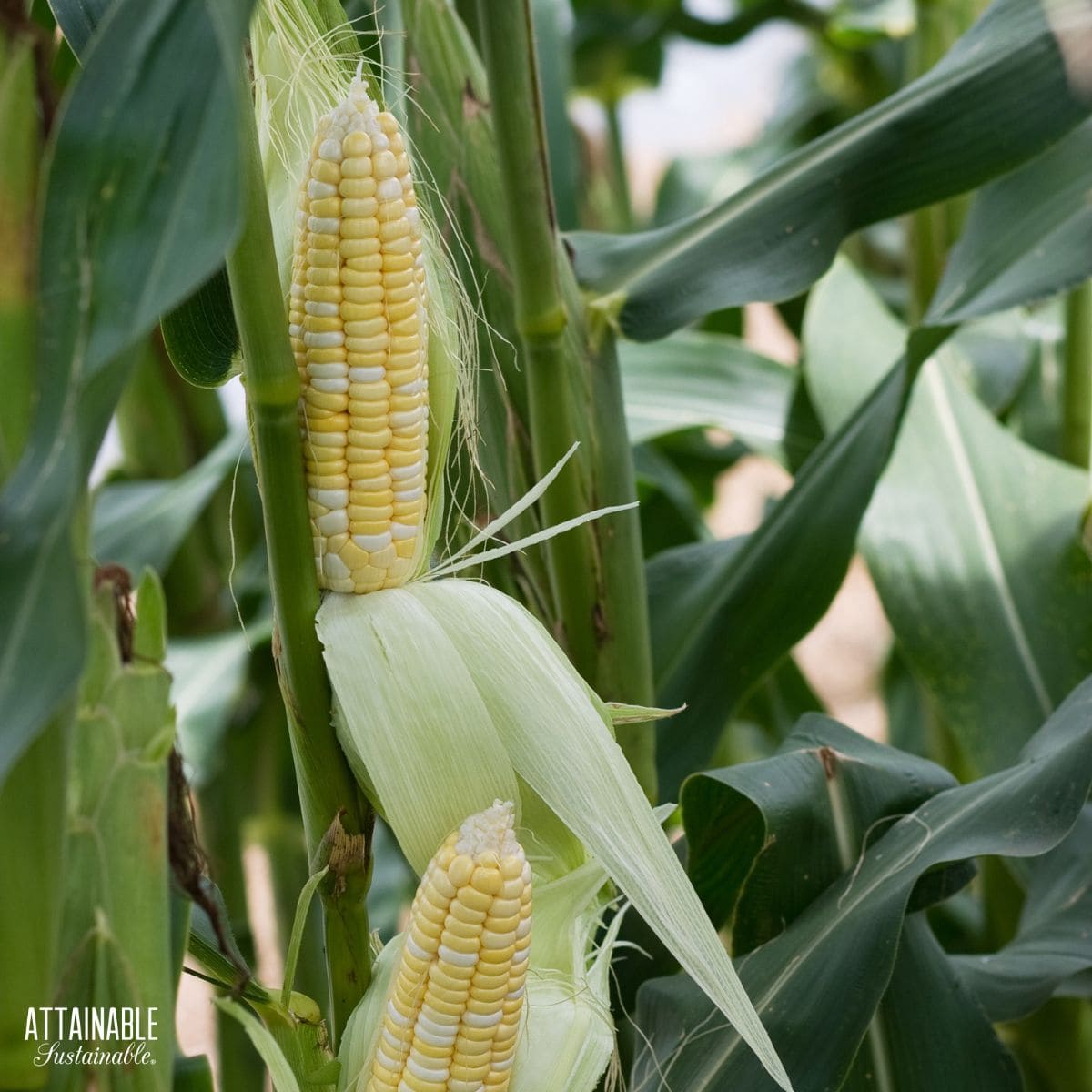

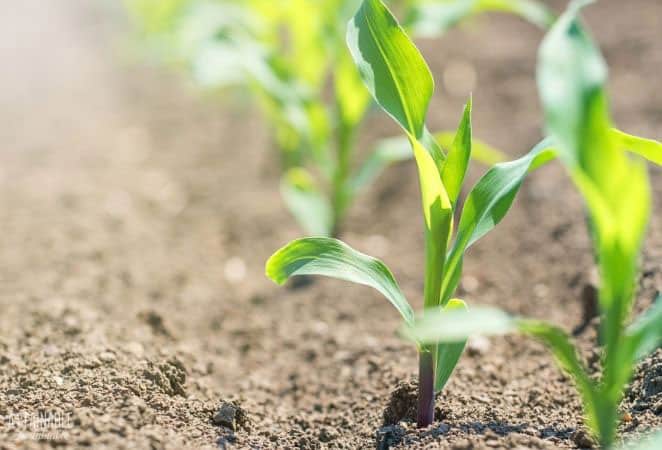
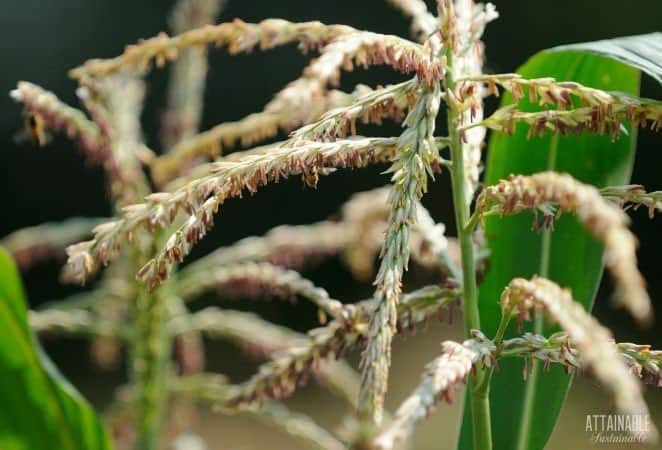


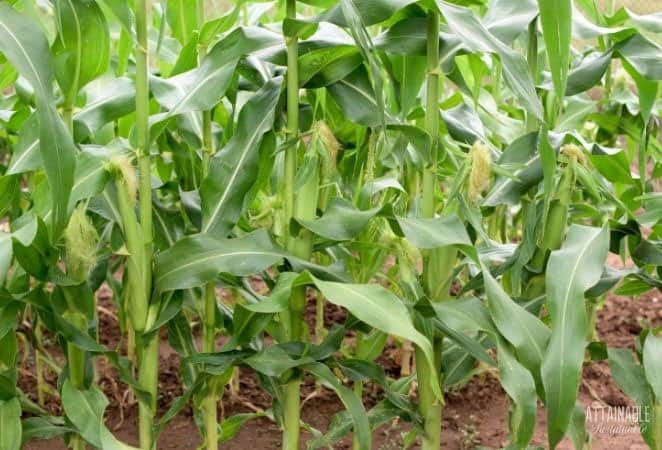
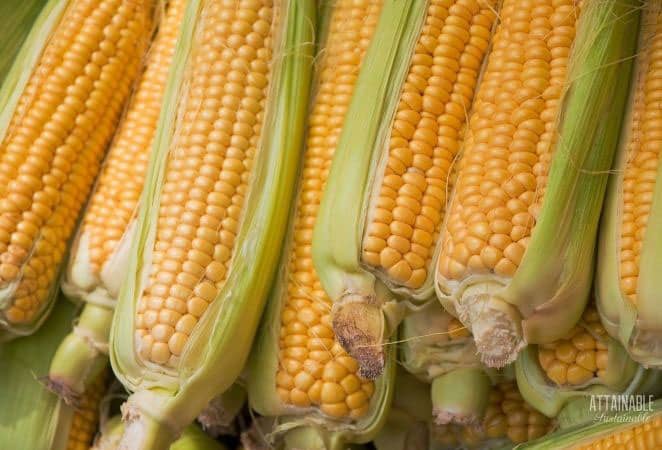
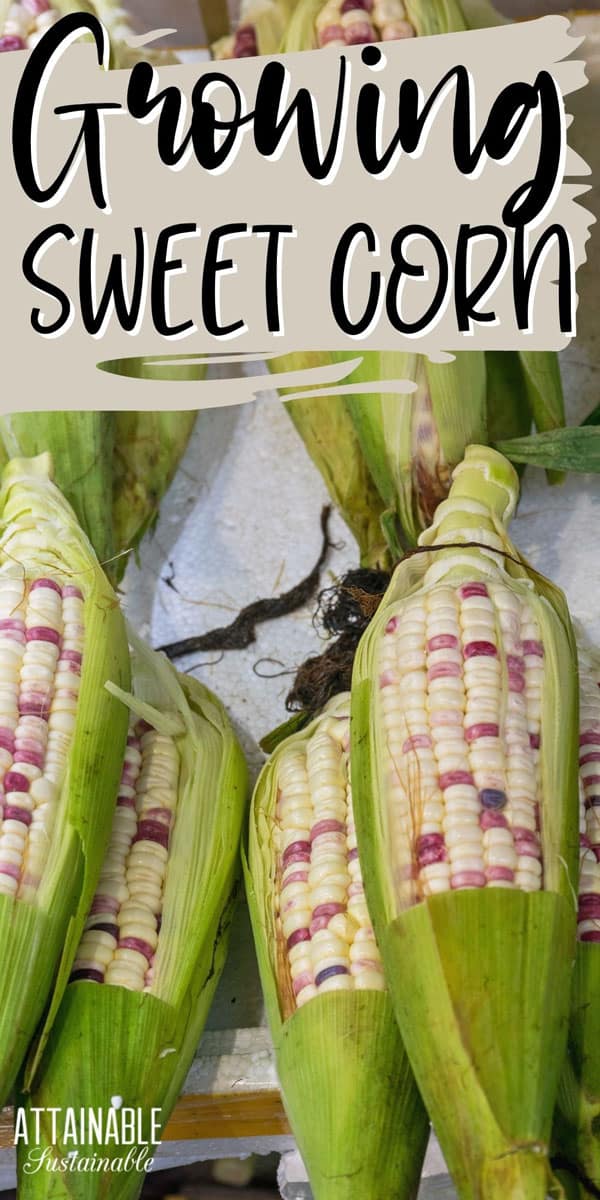
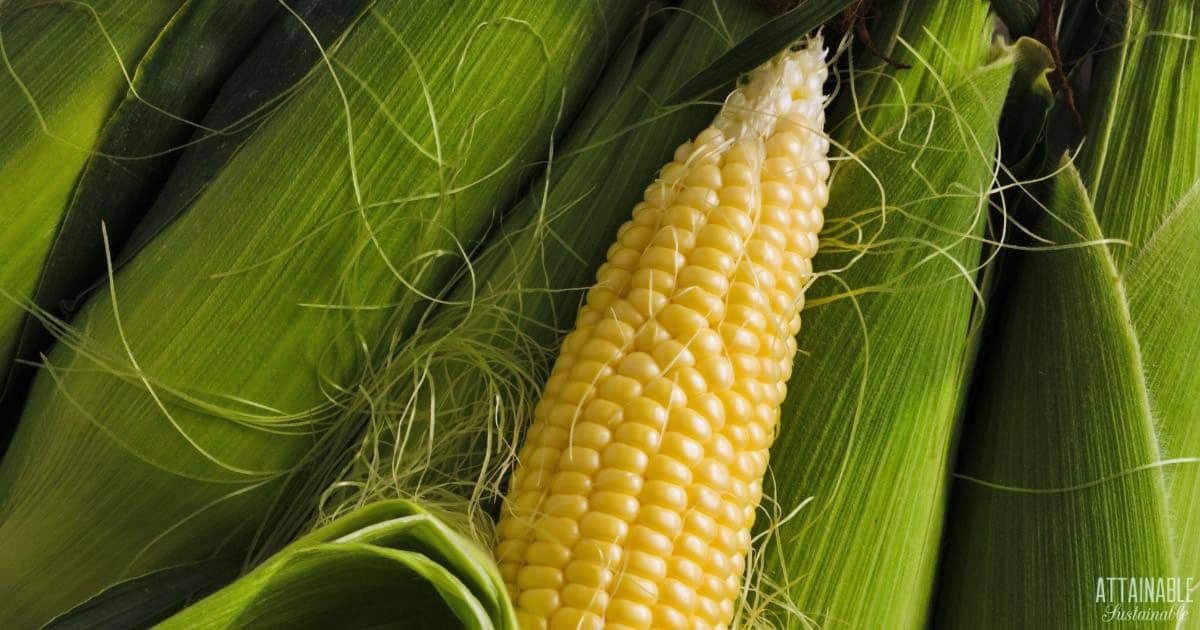





The straw mulch you are talking about, is that the shortcut pieces of straw and do you put it around the corn also or just between the rows of corn?
Yes the short straw will work, and definitely in between rows and if you have extra use it around the corn or anywhere else in your garden.
Thanks for the info! Would you recommend pre-soaking the corn seeds or just putting them directly in the ground?
Corn can really benefit from a pre-soak!
Deer and raccoons are major pests for your corn patch. I had a small patch a few years ago and these pests destroyed my harvest in two nights.
Ugh, yes, pests can be a problem!